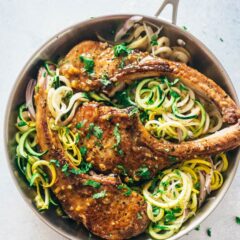
Easy Orange Pork Chops
Tender and juicy pork, perfect brown crust, served in a scrumptious orange sauce. Making weekday dinner couldn’t be easier! {Gluten-Free}
Ingredients
- 4 pork chops bone-in or boneless (*Footnote 1)
- 1/2 teaspoon sea salt
- 1/2 teaspoon freshly ground black pepper
- 2 tablespoon vegetable oil
- 1 cup homemade orange sauce (or bottled sauce)
(Optional) Side
- 1 Shallot , sliced
- 4 zucchini (or 1 pound russet potato) , cut into noodles using a spiralizer
- 1 tablespoon olive oil
- Sea salt and black pepper to taste
Instructions
- If you’re using bone-in pork chops thicker than ½ inch (1 cm), preheat oven to 350 degrees F (176 C).
- Pat dry pork chops with paper towel and place on a large tray. Sprinkle salt and black pepper on both sides.
- Heat a heavy duty stainless steel or carbon steel skillet over medium high heat until hot. Add oil and swirl the pan to coat. Pat dry pork chops again with paper towel. (*Footnote 2) Add pork chops to pan, in two batches if needed. Cook each side for 2 to 3 minutes, until golden brown. If you’re cooking thin-cut chops, they are done now, so you can transfer them to a big plate. Cover the plate with aluminum foil with a slit on top to let the steam out, so the pork will remain crispy. If you’re cooking thick-cut chops, transfer the pan into the oven and bake for 10 to 20 minutes, until the internal temperature reaches 135 F to 145 F (57 C to 63 C) for medium (the USDA minimum temperature is 145 F / 63C), or 145 to 155 F (63C to 38 C) for medium well.
(Optional) Side dish
- Heat oil in a large pan until hot. Add shallot. Cook and stir for 1 minute, until tender.
- Add the spiralized vegetables and a pinch of salt. Cook and stir until the vegetables turn tender, or reached desired doneness. Season with more salt and black pepper, if needed.
Serve
- Heat the homemade orange sauce in the microwave for 1 to 2 minutes, or until hot but not bubbling. Pour onto the pork chops. Serve hot with the vegetables.
Notes
- You can use any cut you prefer. If you use thin pork chops that are ½ inch (1 cm) thick or less, you only need to pan fry them. For boneless thick-cut chops, you can pound them to ½ inch and cook them on the stovetop. If you use a bone-in thick-cut pork chop, it requires finishing in the oven. For more information, scroll up to read the “pork chop cooking time” in the blog post.
- If you rest the pork chops for more than 10 minutes, the surface of the pork will become moist. Pat dry to ensure proper browning and less oil splatter.